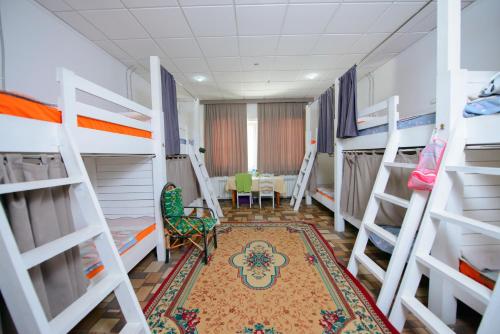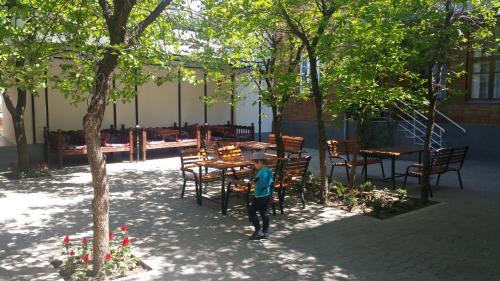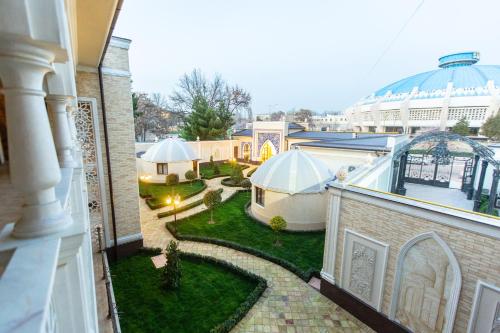The paths that the caravans of the Silk Road once took through Uzbekistan are still quite easy to identify. All you need to do is link the trading posts, which became fortified towns, then wealthy cities.
These cities – like Samarkand, Bukhara, Khiva – are now some of the highlights for visitors to the country, offering a chance to see the heritage of the Silk Road days for themselves.
Tashkent would probably be part of this Silk Road tourism trail as well if it wasn’t for two things.
The first is the earthquake of 1966 that left about 300,000 people homeless and significantly damaged much of the city’s historic old town.
And the second is the Soviets, who were already trying to make their mark in Tashkent and saw the earthquake’s destruction as an opportunity to build a model Soviet city, rather than restore the damaged heritage.
While there are still some things to do in Tashkent from those early years, it’s the more recent influences from the Soviet era that have the bigger impact on the city you see today. Many of the landmarks and infrastructure – like the metro system – remind you that this was part of the USSR less than 30 years ago.
But, as you explore Tashkent, you’ll also see more contemporary architecture, as the authorities try to define the new identity of the city since independence.
And, of course, there are the traditional elements that have lived on through the generations, regardless of natural disasters or political rule. Things like the national dish plov, that is treated almost as a sacred icon, and the warm hospitality, an important part of the culture for people who have been welcoming travellers for centuries.
Tashkent has grown to become the largest city in Central Asia and, in some ways, it feels quite different to the rest of Uzbekistan. But that’s one of the reasons it’s such an interesting place to visit. There are lots of things to do in Tashkent that you won’t find in other parts of the country.
It’s easy to spend a couple of days in Tashkent, exploring the heritage of the city and enjoying the Uzbek culture. To help you plan a trip, I’ve put together my suggestions for the best things to do in Tashkent.
The places I’ve recommended are marked on the map above. You can open it on your phone as you explore Tashkent to see what is near you.
Hazrat Imam Mosque
The Hazrat Imam Mosque may look old and, certainly, the architectural style is from the 16th century – but it was actually only built in 2007. Still, it’s the largest place of worship in Tashkent and one of the city’s most important sites.
The mosque sits on one edge of Khast Imam, a complex in the old town that is the religious heart of Tashkent and has been an important area for centuries.
The mosque is beautifully decorated and worth visiting, but the most significant thing is in a different building.
Hazrat Imam Mosque is open from 9:00 – 21:00.
Admission is free.
Muyi Mubarak Library
The Muyi Mubarak Library may be just a small building behind the Hazrat Imam Mosque, but go inside and you’ll find the Uthman Koran on display.
This copy of the Koran is from the 8th or 9th century and the people here claim it is the oldest Koran in the world. I say ‘claim’ not because I think they are lying but just because it’s been impossible to prove.
Regardless, it’s certainly old and is impressive by any measure. Look for the red dots on one page that is said to be the blood of the third caliph Uthman, who was apparently murdered while reading it.
The rest of Khast Imam
There are a few other things to see in Khast Imam but none is particularly impressive. There’s the small Barak Khan Madrasa that has a colourful facade but is, unfortunately, full of souvenir stalls inside.
There’s also the Tellya Sheikh Mosque which is not as busy since the new one was built but still has some nice elements to see.
Chorsu Bazaar
Central Asia may be known historically for the Silk Road but I love that everywhere you go, you still find vibrant bazaars that give you a small sense of what it may have been like.
The Chorsu Bazaar in Tashkent is one of the best in the region and, even if you don’t want to buy anything, it’s worth the visit.
From an architectural perspective, I love the central blue dome and the way the pattern on the ceiling creates an amazing effect as you wander amongst the tables of vegetables, meat, and snacks.
The bazaar extends outside too and it’s through these alleys that you’ll find all the other goods. Don’t be surprised if you get offered some tastings along the way!
Chorsu Bazaar is open Monday to Friday from 5:00 – 20:15
Saturday from 5:00 – 21:00
Sunday from 4:30 – 21:00
Admission is free.
Alay Bazaar
Although it’s not as bustling as Chorsu, you may want to also visit Alay Bazaar. It is centrally located and much more convenient to get to – for both tourists and locals. For this reason, it is more expensive.
I like seeing the contrast of a more upmarket bazaar, where the displays feel a bit more like a department store than a street stall. It’s a different style of architecture as well, showing you a more modern take on Uzbekistan style.
Alay Bazaar is open daily from 7:00 – 10:00.
Admission is free.
State Museum of History of Uzbekistan
If you’re going to visit one museum in Tashkent, this is probably the one. It’s not incredible by world standards but it has a good range of exhibits that show the history of Uzbekistan over the past 2000 years or so.
One floor tells the story from ancient times through to the Soviet era and you’ll see how religion changed and the impact on society from different cultures that passed through.
The top floor is dedicated to Uzbekistan since independence and has a completely different feel. It comes across as propaganda, talking about how great the industry and athletes are, for instance – but I guess that’s interesting in its own way.
It’s also worth noting that the architecture of the building is really interesting and you can obviously see it from the outside without paying an entrance fee.
It was part of the redevelopment of Tashkent after the 1966 earthquake and this is probably one of the first (and best) examples of the new style that formed, blending a Soviet approach with Central Asian themes.
The State Museum of History of Uzbekistan is open Tuesday to Sunday from 10:00 – 17:00.
It is closed on Monday.
A standard ticket is 60,000 SOM (US$4.71).
Navoi Theatre
Not far from the museum is the Navoi Theatre, the national ballet and opera house of Uzbekistan.
It’s a lovely building but is a little controversial because Japanese prisoners of war were used to build it in the 1940s. Still, it has all the grandeur you would expect from a Soviet theatre.
If there’s a performance when you’re in town, it’s certainly worth going along because you can normally get a ticket for about $5 or so. Be sure to wear some decent clothes – it is the opera, after all!
Independence Square
Also nearby is Independence Square, which used to be called Lenin Square during the Soviet era. It’s used for large gatherings on important national days and has a number of significant monuments.
There’s a large-scale redevelopment going on at the moment so you can’t access a lot of it, but you can still see some of the fountains, which are a popular meeting place for locals.
Monument to Courage
Just a bit further down the street is the Monument to Courage, a memorial for the 1966 Tashkent earthquake. Although there was enormous damage to the city, the death toll is said to be less than 200 people (although there has never been an independent study into that number).
This monument is mainly a tribute to the people who came from all across the Soviet Union to rebuild the city in the years afterwards.
Saligokh Street (Broadway)
From Independence Square, you can head down Saligokh Street, which connects you to the city’s other large space, Amir Timur Square.
The street has the nickname ‘Tashkent Broadway’, although it looks nothing like its New York namesake. But it is a fun area full of food stalls, carnival games, and an art show.
Amir Timur Square
In the centre of Amir Timur Square is a large statue of the man who the space was named after. Timur is a national hero and was a conquerer who was born in Uzbekistan and expanded his empire to Iran, much of Central Asia, and parts of India and Turkey.
The square itself is pleasant and you’ll see lots of locals hanging out here. But it’s also a good place to get your bearings for some of the other sights that you’ll find around its edges.
Hotel Uzbekistan
The most obvious sight is the Hotel Uzbekistan, the enormous accommodation with a distinctive facade. For better or worse, it’s become one of the most recognisable landmarks in the city.
You can go inside the foyer if you’re interested, and there’s also a strange bar with good views at the top.
Amir Timur Museum
The design of this museum is supposed to reflect the Gur-i Amir mausoleum in Samarkand, where Amir Timur is entombed – and it’s probably the architecture that is the most interesting thing about the museum.
It’s really aimed at educating locals more than entertaining tourists so unless you have a particular interest, it’s probably just worth admiring from the outside.
Amir Timur Museum is open Tuesday to Sunday from 10:00 – 18:00.
It is closed Monday.
A standard ticket is 25,000 SOM (US$1.95).
House of Photography
I think that the House of Photography, on the other side of the square, is much more interesting to visit. It has constantly changing exhibitions showing works from Uzbekistan and international artists.
It’s a good way to get an insight into the modern art scene and see how young photographers are viewing their own country these days.
House of Photography is open Tuesday to Sunday from 10:00 – 17:00.
It is closed on Mondays.
Admission is free.
Tashkent Metro
Getting around Tashkent is actually quite easy. Using a ride-sharing app like Yandex is often the best option for tourists if you want to save time.
But, if you’re going between locations near Metro stations, then I would recommend doing that. Firstly, it’s very efficient. Secondly, it only costs about 15 cents per trip. And, thirdly, each station is a work of art!
This is really the reason to take the Metro – and I would suggest doing it just for the sake of it. The designs of the stations are stunning, each with its own theme. They tell the stories of Soviet success, of local industry, of traditional architecture, and much more!
Plov Centre
The national dish in Uzbekistan is plov and you’ll find it everywhere you go. It’s similar to pilaf and is essentially rice simmered in a thick stew of meat and vegetables. Most commonly it’s cooked with lamb fat and served with bits of lamb.
Although you can eat it anywhere, some of the best in Tashkent is at the Plov Centre. Here, you’ll see them making it in enormous pots that can serve hundreds of people.
Have a look at it being cooked outside then go and take a table inside and place your order. If you’re feeling brave, you can get some extra horse meat on top!
The Plov Centre is open from 9:00 – 22:00.
Admission is free.
Tashkent TV Tower
Right next door to the Plov Centre, you’ll see the enormous tower rising up above everything else. This is the Tashkent TV Tower and, at 375 metres high, proudly proclaims to be the 11th tallest in the world.
You can go up to a viewing platform in the tower but it’s only 100 metres high – the rest of the structure is closed off for visitors.
I wouldn’t say it’s worth making the effort to come out here but, if you’re already close, you may as well get another perspective of Tashkent.
Tashkent TV Tower is open daily from 10:00 – 13:00 and 14:00 – 20:00.
A standard ticket is 40,000 SOM (US$3.15)
THE BEST ACCOMMODATION IN TASHKENT
The most iconic accommodation in Tashkent, Hotel Uzbekistan, has seen better days (although you may like its Soviet history), so here are some nicer options.
BACKPACKER

There are a few hostels in Tashkent but I would recommend the popular Topchan for a good backpacker experience.
BUDGET

For a budget option, the Gulnara Guesthouse is a friendly and comfortable place.
BOUTIQUE

With traditional style used for the design of Mirzo Boutique Hotel, it’s a great place for something a bit upmarket.
LUXURY

And, of all the five-star hotels in Tashkent, I think the Hyatt Regency is the best one.
This publication is made possible by the support of the American People through the United States Agency for International Development (USAID) Competitiveness, Trade, and Jobs Activity in Central Asia. The contents of this publication are the sole responsibility of Time Travel Turtle and do not necessarily reflect the views of USAID or the United States Government.